How to Cite | Publication History | PlumX Article Matrix
Suresh Mitthra, Arumugam Karthick, Balasubramaniam Anuradha, Radhakrishnan Mensudar, Kalyani Ramkumar Sadhana and Gurubaran Nidhya Varshini
Department of Conservative Dentistry and Endodontics, Sree Balaji Dental College and Hospital, Bharath University, Chennai, Tamil Nadu, India.
Corresponding Author E-mail: malu.dr2008@yahoo.com
DOI : http://dx.doi.org/10.13005/bbra/2374
ABSTRACT: Following the developments in industrial robotic technology, robotics has found its way into the medical field and is used in a wide range of surgical disciplines. Nanorobots are robots whose components are at the scale of nanometer (10-9 meter) and are considered as the most useful gift of nanotechnology to medical sciences. This review article briefly highlights the significance of nanorobots in various applications in dentistry with improved accuracy, predictability, safety, enhanced treatment quality.
KEYWORDS: Nanorobots; nanodentistry
Download this article as:| Copy the following to cite this article: Mitthra S, Karthick A, Anuradha B, Mensudar R, Sadhana K. R, Varshini N. G. Nanorobots – A Small Wonder. Biosci Biotech Res Asia 2016;13(4). |
| Copy the following to cite this URL: Mitthra S, Karthick A, Anuradha B, Mensudar R, Sadhana K. R, Varshini N. G. Nanorobots – A Small Wonder. Biosci Biotech Res Asia 2016;13(4). Available from: https://www.biotech-asia.org/?p=17415 |
Introduction
A robot is a machine-driven agent, that is guided by a computer program, when it is at or close to the a microscopic scale of nanometers, it is called nanorobotics[1].
The nanorobotic theory says that they are microscopic in size, it would be necessary for a very large number of them to work together to perform both microscopic and macroscopic errands” [2,3].
Approaches For Nanorobots
Binary approaches were suggested for manufacturing nanorobots: organic and inorganic. Organic nanorobots are bio-nanorobots that are established on the progression of adenosine triphosphate and deoxyribonucleic acid to attain actuation for nanorobots. Inorganic nanorobots are based on either diamondoid materials or fullerenes[4,5,6].
Morphology Of Nanorobots
Dental nanorobots are spider like structures that help in completing their tasks promptly. They are fabricated from diamondoid structures, disposed into nanotubes, as the super-sleek surfaces should reduce to a merest chances of activating the defense mechanism of the host [2,6,7,8,9].[Fig.1]
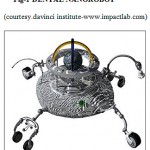 |
Figure 1: Dental Nanorobot |
Components Of Nanorobots
The dental nanorobot will have a nanocomputer on board which will stock and perform planned errands, will pocket and process signals and external stimuli, will interact with other nanocomputers and will acknowledge to external authority devices. A navigational network installed in the body, provide high topographical accuracy to all circulating nanorobots and keep track of the various devices in the body. A camera which gives the exact location of the nanorobots present within the body. Assembling nanorobots involve actuators, sensors, power, control, communications and interfacial signals across spatial scales and between organic and inorganic systems [6,7]. [Fig-2]
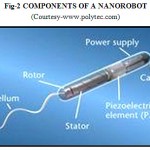 |
Figure 2: Components of A Nanorobot |
Mechanism of Action
Once inside the human body, nanorobots reaches the target sites as it was preprogrammed in the nanocomputer on board, by utilizing the internal sources (the energy liberated by the radioactive fragments attached to the nanorobot body ), but also the external sources (such as the host’s body heat or the electrolytes and the metabolism of the glucose in the blood flow) of energy.
When the target of the nanorobot is achieved, they are retrieved by granting their exit via the usual human excretory channels. They may also be cleared away by active scavenger systems called nano-terminators[1,2,10].
Biomedical Applications
Its application in nanomedicine was to recognize cancer cells and demolish them. Nanorobots can be practiced in chemotherapy to combat cancer through exact chemical dosage administration and a comparable approach could be taken to enable nanorobots to hand over anti-HIV drugs. Such drug distributing nanorobots have been termed “Pharmacytes”[11].
To cure dermatological diseases, a paste containing nanorobots is used. It removes the exact amount of dead skin, removes surplus oils, adds lacking oils and achieves deep pore cleansing [6].[Fig-3]
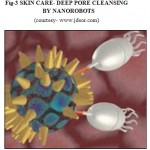 |
Figure 3: Skin Care- Deep Pore Cleansing By Nanorobots |
Medical nanorobots invigilate diabetes by restricting nutrient concentrations in the human body, including blood glucose level in diabetic patient [2].
Nanorobots are also used to deliver drugs, they expel the medication directly to the target location and become active only after reaching the target, so other parts of the body remain unaffected [12,13].[Fig-4]
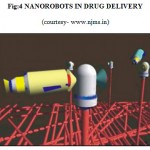 |
Figure 4: Nanorobots In Drug Delivery |
Nanorobots facilitate in diagnosis and biopsy. They circulate in the bloodstream or tissue throughout the body looking out for any abnormalities. When nanorobots spot any unwanted deposits or damaged organs, they take steps to remove those deposits and repair damaged organs[2].
Dental Applications
Inducing Local Anesthesia
A suspension of anesthetic dental nanorobots is imported into the area where anesthesia is required. Upon stimulation by the dentist, these robots will block the sensory nerves from transferring pain sensation. After the dental procedure is completed, the devices can be directed to unblock the nerves and de-activate them [2,9,14].[Fig-5]
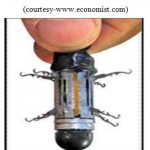 |
Figure 5: Nanorobotic Anesthesia |
Treatment of Dentine Hypersensitivity
Another pathology we commonly come across in dental practice is the dentine hypersensitivity, these dental nanorobots will selectively clog specific dentinal tubes in a few minutes, using bio-friendly ingredients and offers the patient an immediate solution to treat hypersensitivity [1,10,13].
Cavity preparation and restoration
Multiple nanorobots work in unison, invisible to the naked eye, also help in cavity preparation and restoration of teeth. The cavity preparation is restricted to the demineralized enamel and dentin, thus conserving the sound tooth structure [3,15,16,17].
Maintenance of Oral Hygiene
Dentifrobots play a crucial role in preventing cavities. Their daily application is by the means of mouthwash or toothpaste. They can easily reach places a tooth brush can’t reach, dentifrobots will pin point and destruct pathogen bacteria in the sub-occlusal area while permitting the harmless bacterial flora to grow undisturbed[18,19,20].
Orthodontic Treatment
The orthodontic nanorobots, alter the periodontal tissues, including gums, periodontal ligament, cementum and alveolar bone, allowing a rapid and painless straightening, rotating or vertical positioning [2,15,18].[Fig-6]
 |
Figure 6: Orthodontic Nanorobots |
Conclusion
Nanorobotics has strong potential to revolutionize dentistry with improved accuracy, predictability, safety, quality of care and speed of diagnosis and treatment [21]. Although research into nanorobots is still in its primitive stages, the scope for such technology is tremendous!
References
- Jhavei H.M, BalajiP.R. Nanotechnology. The future of dentistry a review. Jr I Prosthetic. 2005; 5: 15-17.
- Cavalcanti A. Manufacturing Technology for Medical Nanorobots. Asia Pacific Nanotechnology Forum News Journal 2007;6 (1).
- Sujatha V, Malathi Suresh, Mahalaxmi S. Nanorobotics- a futuristic approach. Streamdent – SRM University journal of dental Science 2010; 1(1):86-90.
- Lumbini P. Nanorobotics in dentistry. Annals of Dental Speciality 2014; 2(3) : 95-96.
- Sujatha V, Malathi Suresh, Mahalaxmi S. Carbon Nanotubes- a review. Streamdent – SRM University journal of dental Science 2011; 2(4):313-320.
- Freitas RA jr., Computational Tasks in medical nanorobotics. Journal of computational and theoretical Nanoscience 2009; 2:391-428.
- Xing Z, Dai L. Nanodiamonds for Nanomedicine 2009;4(2):207-218.
CrossRef - Dutta P, Gupta S. Understanding of Nanoscience and technology. Global vision publishing house, Delhi,India 2006; 43-44.
- Ana Maria D, Cristina D. Dental Robots- small instruments with large potential. Romanian journal of oral rehabilitation 2011; 3:77-82
- Schleyer TL. Nanodentistry fact or fiction. J Am Dent Assoc 2000; 131:1567-1568.
CrossRef - Frietas R.A. nanodentistry. J Am Dent Assoc 2000;131(11):1559-1569.
CrossRef - Amit Bhargava. Nanorobots: The future of medicine 1999, foresight.org.
- Sneha R Bhat, Aravind R Kudva, Harish K Shetty, Amarnath Shenoy. Nanodentistry- A realistic future! Archives of medicine and health sciences 2013; 1(2): 178-182.
- Malathi Suresh, V.Sujatha, S.Mahalaxmi. Nanotechnology-an asset to dentistry. International Journal of Community Dentistry 2014; 5(1)27-31.
- Shashank Babel, Shomit Mathur. Nanorobotics-Headway towards Dentistry. Int J of Research in Science and Technology 2011; 1(3): 87-92.
- Deepak Ranjan Dalai, D.J Bhaskar, Chandan Agali R, Nisha Singh, Devanand Gupta, Swapnil S Bumb. Futuristic application of Nano-Robots in dentistry. International Journal of Advanced Health Sciences 2014; 1(3):16-20.
- H.Chen. update on dental nano composites.J dent res 2010;89:549-60.
CrossRef - Sanjeev Kumar Verma, K.C.Prabhat, Lata Goyal, Manita Rani, Amit Jain. A critical review of the implication of nanotechnology in modern dental practice. National journal of Maxillofacial Surgery 2010; 1(1):41-44.
CrossRef - Saravana R Kumar, R Vijayalakshmi. Nanotechnology in dentistry. Indian journal of dental research. 2006; 17(2):62-65.
CrossRef - Abilash M. Nanorobots. Intenational Journal of pharma and bio sciences 2010; 1(1): 1-10.
- Malathi Suresh, Sujatha V, Mahalaxmi S. The role of nanoparticles and nanodevices in nanomedicine. Research journal of pharmaceutical biological and chemical sciences 2014; 5: 1869-1879.

This work is licensed under a Creative Commons Attribution 4.0 International License.





